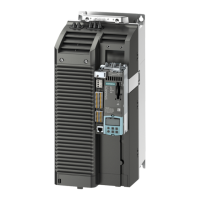Siemens S120_EN_rev06-08062017.docx 5-9
5.2.1.5 Technical data
Table 13 Technical data, Braking Modules
Suitable for installation in Power Modules, frame size
Variable response thresholds
Low signal level
(an open digital input is interpreted as "low")
Current drain (typical at 24 VDC)
Max. cross-section that can be connected
Digital output (continued-short-circuit-proof)
Max. load current of the digital output
Max. cross-section that can be connected
Max. connection cross-section R1/R2
5.2.2 Description Braking Resistors
The braking resistor is used to reduce the excess DC link energy in regenerative operation.
The braking resistor is connected to the Braking Module. The braking resistor is mounted outside the cabinet
or switchgear room. This means that the resulting heat loss around the Power Module can be dissipated -
and cooling costs/equipment reduced.
Resistors with unit ratings of 25 kW and 50 kW are available.
Braking resistors can be used on Power Modules with a voltage range. This is the reason that the voltage
can be changed by setting the response thresholds at the Braking Module to reduce the voltage stress on
the motor and Power Module.
A temperature protection switch monitors the braking resistor for overtemperature and issues a signal on a
floating contact if the limit value is exceeded.
5.2.3 Safety instructions for braking resistors chassis format
Danger to life due to electric shock caused by applied voltage and residual charge of the
DC-link capacitors on the braking module
Contact with live connections on the Braking Module can result in death or serious injury.
Only connect the Braking Module when the Power Module is disconnected.
Only connect the Braking Module after five minutes has elapsed. Measure the voltage before
starting work on the DCP and DCN DC-link terminals
Danger of fire through overheating for insufficient ventilation clearances
Insufficient ventilation clearances can result in overheating with danger to persons.
It is essential that you maintain a cooling clearance of 200 mm on all sides of the component (with
ventilation grills).
Risk of fire and device damage as a result of ground fault / short-circuit
The cables to the braking resistor must be routed so that a ground fault or short-circuit can

